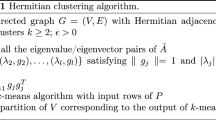Abstract
We propose a methodology for clustering financial time series of stocks’ returns, and a graphical set-up to quantify and visualise the evolution of these clusters through time. The proposed graphical representation allows for the application of well known algorithms for solving classical combinatorial graph problems, which can be interpreted as problems relevant to portfolio design and investment strategies. We illustrate this graph representation of the evolution of clusters in time and its use on real data from the Madrid Stock Exchange market.
Similar content being viewed by others
References
Brockwell P. J., Davis R. A. (2002) Introduction to time series and forecasting. 2nd edn. Springer, New York
Cormen T., Leiserson C., Rivest R., Stein C. (2001) Introduction to algorithms. 2nd edn. The MIT Press, Cambridge
Embrechts, P., McNeil, A., Straumann. (2002). Correlation and dependency in risk management: Properties and pitfalls. In: M., Dempster, H.K. Moffatt (Eds.), Risk management: Value at risk and beyond. Cambridge University Press: Cambridge.
Garey M. R., Johnson D. S. (1979) Computers and intractability. A guide to the theory of NP-completeness. Freeman, San Francisco
Gibbons J.D., Chakraborti S. (1969) Nonparametric statistical inference. Marcel Dekker, New York
Graham B. (2006) The intelligent investor—revised edition/updated with new commentary by Jason Zeig. Collins Business Essentials, New York
Hastie T., Tibshirani R., Friedman J. (2001) The elements of statistical learning. Springer, New York
Liao T. (2005) Clustering time series data: A survey. Pattern Recognition 38: 1857–1874
Otranto E. (2008) Clustering heteroskedastic time series by model-based procedures. Computational Statistics & Data Analysis 52(10): 4685–4698
R Development Core Team. (2009). R: A Language and environment for statistical computing. In R foundation for statistical computing, Vienna, Austria. http://www.R-project.org.
Sociedad de Bolsas Española. (2008). In Technical regulations for the composition and calculation of the Sociedad de Bolsas, S.A. indexes. http://www.sbolsas.com/data/normdef-in.pdf.
Tibshirani R., Walther G., Hastie T. (2001) Estimating the number of clusters in a data set via the gap statistic. Journal of the Royal Statistical Society Series B 63(2): 411–423
Tsay R. S. (2010) Analysis of financial time series. 3rd edn. Wiley, New York
Vidyamurthy G. (2004) Pairs trading, quantitative methods and analysis. Wiley, New York
Author information
Authors and Affiliations
Corresponding author
Rights and permissions
About this article
Cite this article
Arratia, A., Cabaña, A. A Graphical Tool for Describing the Temporal Evolution of Clusters in Financial Stock Markets. Comput Econ 41, 213–231 (2013). https://doi.org/10.1007/s10614-012-9327-x
Accepted:
Published:
Issue Date:
DOI: https://doi.org/10.1007/s10614-012-9327-x




